The Mixed Histories of 5 Pest-Themed Foods
The Mixed Histories of 5 Pest-Themed Foods
There are plenty of foods and drinks that have a name or nickname associated with an animal, whether it makes complete sense or not. Grasshopper cookies, monkey bread, and puppy chow are popular examples of this phenomenon, where the connection between the food and the titular animal is not entirely clear. On that note, there are quite a few food products that have the name of a common pest in its title. We’re not sure who would want to think about these frustrating pests while trying to enjoy a delicious treat, but the popularity of these items prove that it is possible to grow beyond a less-than-ideal name. Some of these items got their names for resembling the pests they share a name with, while others require a bit of thought in order to understand the full meaning of their names. Let’s take a closer look at five of the most popular pest-themed foods and drinks to see where the related pests fall into the surprisingly complex histories behind these treats.
Ants on a Log
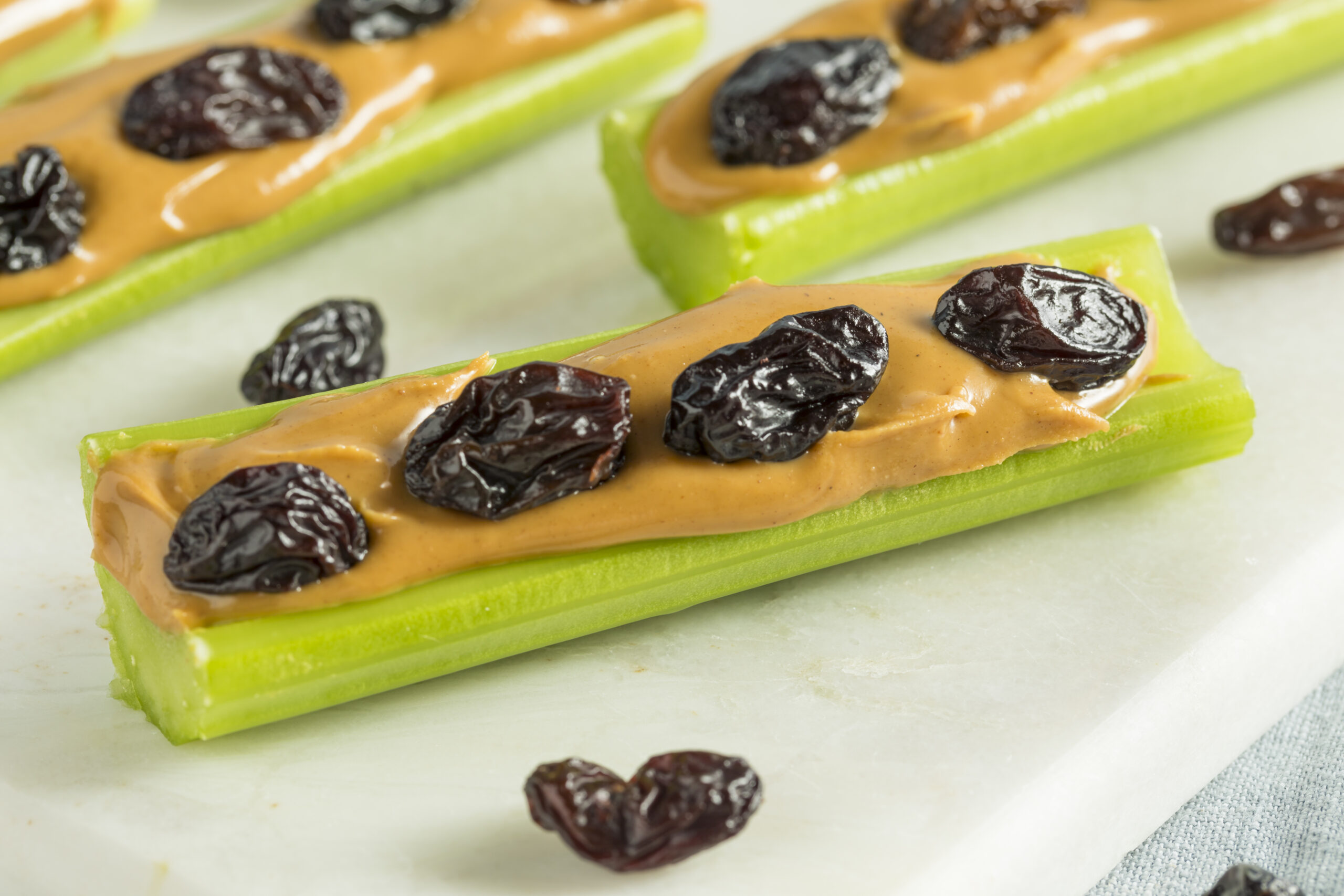
This is arguably the most famous snack on the list, given the fact that it has a national holiday dedicated to its existence. Tomorrow (September 12) is National Ants on a Log Day since it’s the second Tuesday in September, and a great way to celebrate would be to make your own version of this tasty snack at home! It is a straightforward combination of celery sticks, peanut butter, and raisins that is incredibly easy to make. While it seems like there is an obvious answer to the question of this treat’s origins, the history of Ants on a Log is incredibly sparse. It could be a descendent of the popular stuffed celery appetizers that were at parties in the early 20th century, but that is not confirmed. In fact, many of the companies and organizations that are associated with the snack — Sun-Maid, the California Raisin Marketing Board, Dole, the Girl Scouts — have since stated that they do not know its origins either.
The fact that the Girl Scouts organization doesn’t know the origins of Ants on a Log is especially interesting since they are often credited with its creation. This is likely because their 1946 cookbook featured a recipe for an Ants on a Log-adjacent snack, but their version did not include raisins or the famous title. The creation of Ants on a Log will likely remain one of life’s greatest unsolved mysteries, but that doesn’t mean we can’t enjoy this treat today. It has been included in countless children’s cookbooks over the years due to its ease of preparation, making for a classic after-school snack. The basic recipe is to simply spread peanut butter in the crevice of a halved celery stick, then place raisins across the top to resemble ants marching across a log. You can customize this in any way that you want, such as substituting other dried fruit for raisins or a different nut butter for peanut butter. But there is no doubt about it: the classic Ants on a Log has a lasting legacy of being the best possible treat that is associated with annoying ants.
Bug Juice
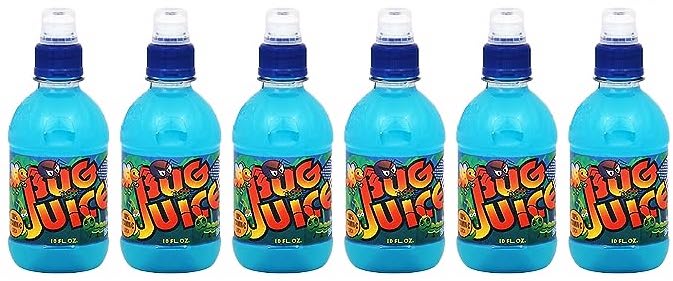
This drink is an outlier from the other four, not only because its origins are clearer, but also because it is a store-bought product that has a rocky history with the store shelves. Named after the generic term for sugary drinks made with a flavored powder, Bug Juice started as a fruit juice that became popular at summer camps and parties in the mid-to-late-twentieth century. If you were a kid in the ‘90s and early 2000s, you may remember this sugary concoction being sold at your local gas station in child-friendly bottles with sports caps. Between the florescent coloring of the liquid and the cartoon bugs on the label, this drink was definitely marketed to the young sugar-craving audience of this time period. Although it claimed to be a “healthy” alternative to other juices and a great source of vitamin C, there are few natural components to this fun beverage. The names of the flavors are more of an exercise in quippy titles than in serious descriptions, with some of the standouts being Straw’Nana, Whistl ’N’ Watermelon, and Leap’N Lemo’N’ade. There are even flavors catering to the “buggy” theme of the product, like Spider Juice and Lady Bug Juice. We only hope that these don’t taste like the creatures they are named after. Of course, anything can be labelled as “bug juice” if you use your imagination. You can even make your own at home by combining powdered fruit drink mix, sugar, and water for a sweet summer concoction!
If the branded beverage was your go-to drink as a child, you may be wondering what happened to it since there was a long stretch where Bug Juice was no longer brightening up the store shelves. This beverage has a surprising amount of controversy in its past. For one, there were a couple of recalls made on the drink during its heyday due to some batches being contaminated by metal shavings (talk about a surprise ingredient). It was eventually discontinued in the 2000s, and there are two prevailing theories for its quick end. One is that parents didn’t want to give their kids sugary juice anymore as more information about healthy eating and food ingredients was being released to the public. Another theory is that those recalls did cause the discontinuation since no one wants to drink something with metal shavings in it, and it’s tough for a business to rebuild its reputation after an event like that. Bug Juice was even involved in a lawsuit back in 2010, when the company sued Jungle Juice for having extremely similar packaging, themes, and designs. But today, Bug Juice has grown beyond its controversial past by currently being sold in certain online retailers and select stores. That’s right: today’s generation of excitable kids can partake in the sugary mixture of bright flavors once again. The Bug Juice website is one of the most notable sellers, mainly because you can find every flavor in one place. On that note, this site is an explosion of ‘90s/2000s nostalgia with its outdated photos and wild graphics, so grab a cold Bug Juice and hop online if you’re in the mood to revisit the turn of the century.
Bee Bread
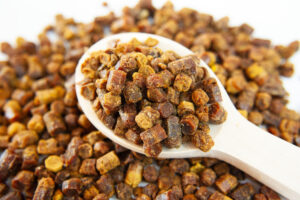
Bee bread from honeybees
Bee bread is an interesting one because it’s both a general name for any bee-themed bread and the actual name for a food that honeybees make themselves! It is basically the combination of pollen, honey, nectar, bee saliva, and other secretions. They place it in the cells of their hive — like they do with honey — and allow it to ferment under a cover of honey. The nurse bees will eat some bee bread to give them enough nourishment to produce royal jelly, the food for larvae. Honeybees are believed to actually eat more bee bread than pollen when they have enough made, but they will settle for pollen in a pinch. Some beekeepers will harvest the bee bread in addition to the honey and pollen, which is how bee bread is available to purchase in certain health food stores and websites. However, bee bread is more difficult to gather since it needs to be dehydrated before it can be separated from the frame.
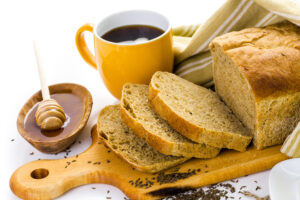
Homemade bee bread
Bee pollen has been a popular health food for centuries, as there are records of ancient civilizations eating bee pollen for its supposed youth-extending benefits. It is still favored by health circles everywhere for its health benefits, help with allergy symptoms, and metabolism-boosting properties. In the same way, bee bread is a superfood due to its antioxidants, nutrients, immunity, and vitamins. It’s possible to purchase bee bread from certain organic food sites, and those who have tried it say that it is a great topping on cereal or yogurt. That being said, bee bread is also a common name that encompasses a variety of man-made treats that relate to bees in some way. Some teachers use this tactic to teach their young students about actual bee bread and the purpose of honeybees. “Bee bread” can mean whatever you want it to, depending on how authentic you want to make it. Some bakers make bee bread by adding bee pollen to their sourdough starters. Others include enough honey in their bread dough to make it noticeable in the end result, thereby technically making bee bread. Overall, bee bread is a fun name for a real bee-created substance and any kind of bread recipe that honeybees would heartily approve of.
Spider Cake
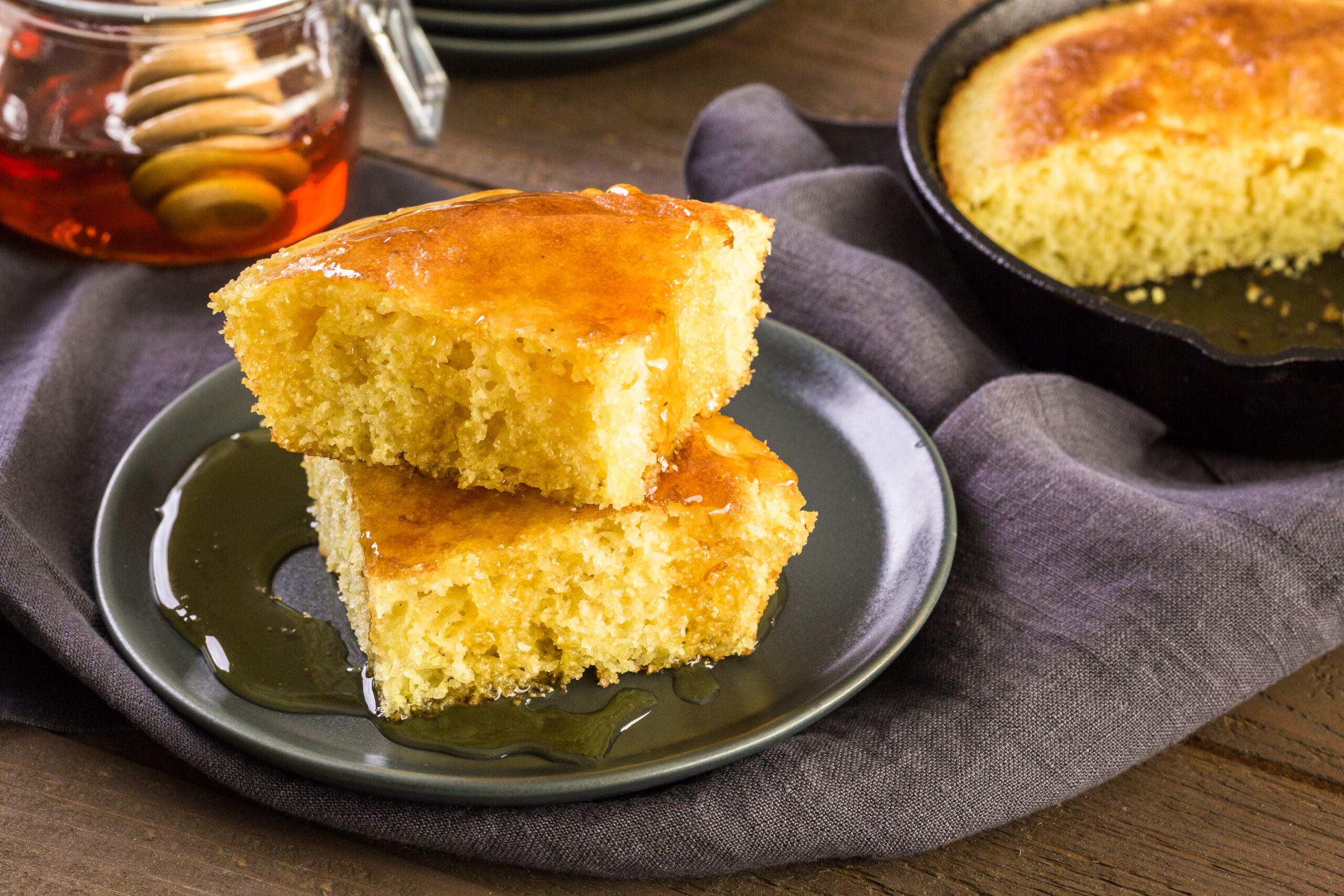
Thankfully, there are no real spiders in this cake. New England Spider Cake is an age-old creation that is simple to make and a joy to eat. It is a cake recipe that uses all of the basic baking ingredients, as well as cornmeal and heavy cream, to make for an entirely new creation. The first recipe for this dessert is thought to have been published in 1884, but that one used milk instead of heavy cream. Cornmeal is an absolute essential to Spider Cake in order to achieve that sweet and salty cornbread-reminiscent dessert. It may not be a pantry staple for many houses today, but cornmeal was undoubtedly in every kitchen across the country during this cake’s invention because it’s an affordable ingredient that can wield many dishes.
So, you may be wondering how this pleasant cake got stuck with a name that is an arachnophobe’s worst nightmare. Some people believe that it is because of how the heavy cream bakes into the cake. The heavy cream is poured in the middle of the batter prior to baking in the cast iron skillet, resulting in “veins” of cream spreading throughout the cake that are reminiscent of spiderwebs. However, the true origins of the name are much more straightforward. In the eighteenth century, the baking vessel required for this dish was also cast iron. It had three legs that allowed it to stand above the hot coals households used to cook their food. The name of this vessel? The spider, naturally. Our cast iron skillets don’t have legs and we now use an oven to bake this cake, but it is still fun to tell people that you are baking a spider cake today. Between the sweetened cornbread base and the ending drizzle of maple syrup, New England Spider Cake is far preferable to the creepy arachnid it happens to share a name with.
Worms in Dirt (Dirt Pudding, Dirt Cups, Cup of Dirt, etc.)
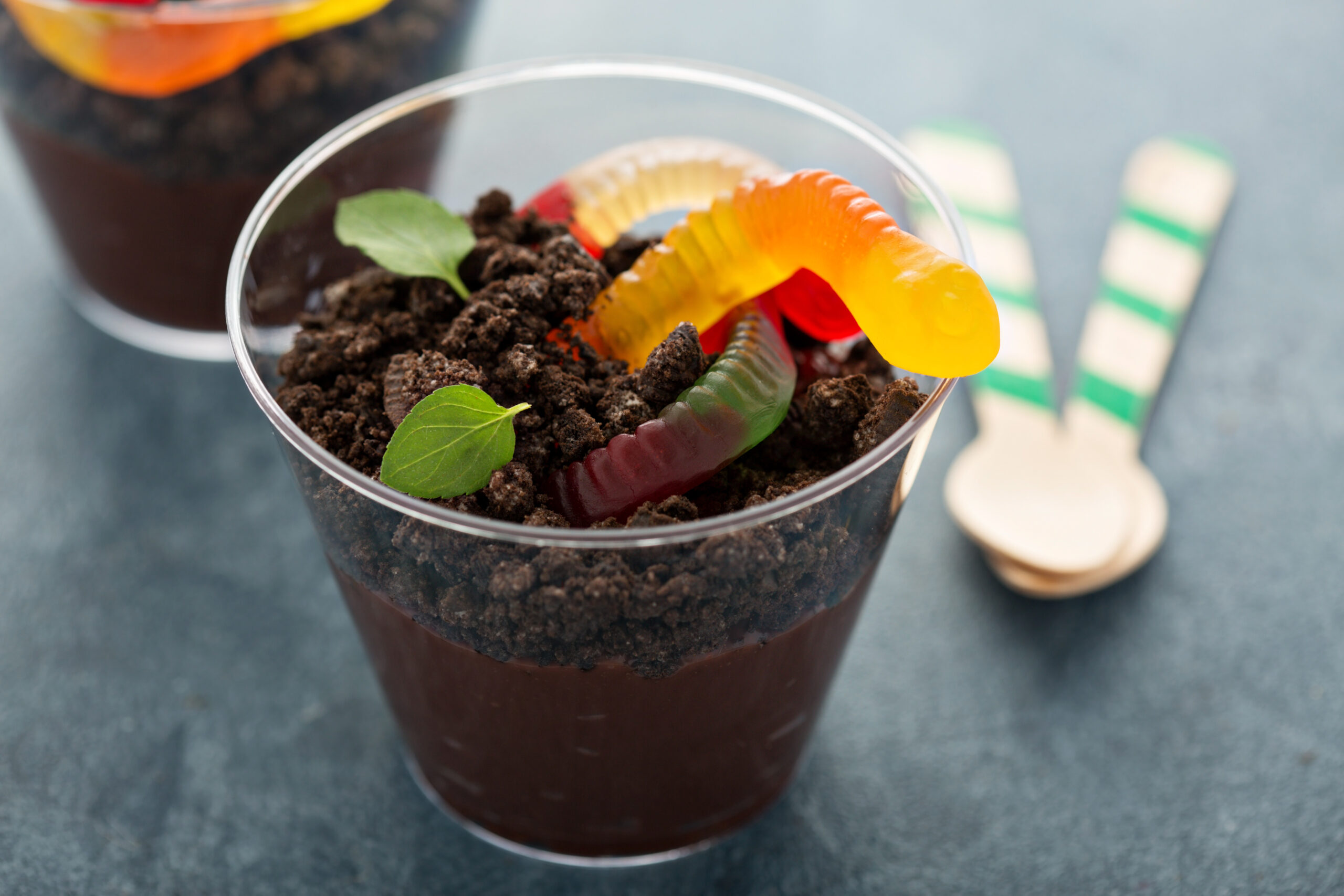
This dessert has all kinds of similar-sounding names, so if you grew up with this treat, you likely heard it called some unique combination of the words listed above. It has been popular in schools, camps, and birthday parties for generations, and for good reason. Dirt cups are almost as easy to make as they are to eat, so eager children are able to make their very own cup under the instruction of an adult. The origins of this dessert aren’t clear (see the theme of this blog?), but the general consensus is that it gained popularity in the 1970s and 1980s. It’s basically an easier version of mud pie, which was also commonly found in certain regions back then. The possibly first publication of a dirt cup recipe was in the 1988 Arkansas Democrat-Gazette, but everyone who made it had their own method by that point. Jell-O joined the party in 1993, where they created an ad with their own “Prehistoric Pudding” recipe to encourage kids to make their own treat. It even featured gummy dinosaurs, but the dirt cup recipe with gummy worms prevailed as the most popular choice.
The ingredients and methods of this dessert are completely dependent on the preferences of the person making it. Dirt cups were a common way for teachers to give a visual aid for their students when talking about sediment layers and what worms do in the dirt all day. If you were one of the kids fortunate enough to make your own dirt cup in science class, you likely remember the excitement that came with being encouraged to eat dessert in the classroom. The versions of dirt cups that were used in classrooms, summer camps, and daycares were the simplest types possible, and understandably so. All you really need are instant chocolate pudding (sediment), chocolate sandwich cookies (topsoil), and gummy worms (earthworms). Home bakers elevated this basic recipe by adding whipped topping, butter, cream cheese, and powdered sugar to the pudding. This thickens the base layer and makes it easier for young chefs to build their own dirt cups. The top layer of the cups can even be beautified, as some bakers like to add colorful candies or flowers made of frosting to make it look like a garden. Considering the fact that earthworms eat decaying plant matter and organisms, a dirt cup is much more enjoyable when you don’t think about the pest it has always been associated with.
The Sweetest Treat is Receiving Services From Pointe Pest Control
These treats are delicious concoctions that paint these pests in a much more appealing light, but the real creepy-crawlies are never something we want in our homes. Insects, spiders, and rodents all bring their own problems to anyplace that they invade, and it can feel completely overwhelming to deal with a full infestation. At Pointe Pest Control, we understand the frustrations that come with pest problems of any kind, and we are dedicated to making the control process as smooth as possible. Our technicians are all highly-trained in the safest and most efficient ways to solve all kinds of pest problems. Plus, our treatments are all safe for people and pets, so you never have to worry about toxic pesticides contaminating your home. We guarantee 100% satisfaction with every service. Contact us for more information on our thorough services and to learn how Pointe will ensure that the only bugs in your kitchen are of the gummy variety!
Citations
Agar, J. (2010, March 26). Michigan juice makers Bug Juice, Jungle Juice embroiled in lawsuit over packaging. MLive. Available at https://www.mlive.com/business/west-michigan/2010/03/michigan_juice_makers_bug_juic.html (Accessed on August 31, 2023).
Antonace, C. (2023, April 17). Take a nostalgic trip with some classic ‘dirt pudding.’ Daily Meal. Available at https://www.thedailymeal.com/1259540/dirt-pudding-nostalgia/ (Accessed on August 31, 2023).
Bailey, S. (2009, January 26). Insect-themed party food. Entomology at the University of Kentucky. Available at https://entomology.ca.uky.edu/content/insect-themed-party-food (Accessed on August 31, 2023).
Elubanji, O. (2022, November 25). When did bug juice drink come out. Upthirst. Available at https://www.upthirst.com/when-did-bug-juice-drink-come-out/ (Accessed on August 31, 2023).
Lau, J. (2023, July 24). What happened to bug juice updated 8/2023. Chesbrewco. Available at https://chesbrewco.com/what-happened-to-bug-juice-drink/ (Accessed on August 31, 2023).
Manner, C. (2023, January 15). Do they still make bug juice?. Still Sold. Available at https://stillsold.com/food-and-beverage/bug-juice/ (Accessed on August 31, 2023).
Meemaw. (2017, September 14). Dirt pudding – A classic kid’s dessert from the 1970’s that’s still a home run. Meemaw Eats. Available at https://www.meemaweats.com/dirt-pudding-kids-dessert/ (Accessed on August 31, 2023).
Nico. (2022, December 14). 7 bee bread benefits (with recipe ideas). Documenting Simple Living. Available at https://documentingsimpleliving.com/bee-bread/ (Accessed on August 31, 2023).
Schaltegger, M. (2019, June 7). A case for bug juice: Our favorite nostalgic drink deserves so much more respect. Delish. Available at https://www.delish.com/food/a27817295/flashback-friday-bug-juice/ (Accessed on August 31, 2023).
Scott, E. (2022, December 22). Bee pollen and bee bread: Natural superfoods. Best Bees. Available at https://bestbees.com/2022/12/22/bee-pollen/ (Accessed on August 31, 2023).
Sever, S. (2019, November 5). The story behind New England Spider Cake: The sweet, quirky cornbread with a surprise inside. The Kitchn. Available at https://www.thekitchn.com/new-england-spider-cake-22948875 (Accessed on August 31, 2023).
Weinraub, M. (2019, September 12). The weirdly untraceable origin story of ants on a log. Food52. Available at https://food52.com/blog/24538-what-is-ants-on-a-log (Accessed on August 31, 2023).
Wilson, E. (2021, January 5). Let’s take a crawl through the life and times of Dirt Cups. The Takeout. Available at https://thetakeout.com/history-of-the-dirt-cup-dessert-gummy-worms-pudding-1845888139 (Accessed on August 31, 2023).
Request a Free Quote Today
(We do not share your data with anybody, and only use it for its intended purpose)


